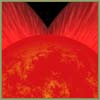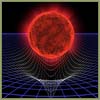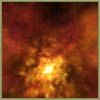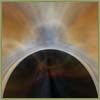
Birth of a Black Hole
Black holes, like the rest of us, are born from stars.*
While the elements that make up our bodies and everything else
on Earth originated in exploding stars, black holes arise
after massive stars burn up all their nuclear fuel, explode in
a supernova, and collapse to an unimaginably dense point
called a singularity. In this slide show, follow the
progression of events from old, dying star to newborn black
hole.—Peter Tyson


|
|
A young, massive star creates energy by nuclear fusion,
converting hydrogen into helium. That's what makes it
shine. When all the hydrogen in the core is used up, the
star begins fusing an outer shell of hydrogen that lies
beyond what is now a helium core. At this later stage in
its life, the star expands into a red supergiant (shown
here).
|


|
|
If you were to split the red supergiant open, you'd find
a massive core. Here, deep inside, the sheer volume of
matter is drawn inward by its own gravity. The
temperature of the core eventually rises high enough to
begin nuclear fusion of the surrounding helium.
|


|
|
The pressure sends temperatures soaring above a billion
degrees, and the rising gravitational force makes
lighter elements fuse into heavier ones: first helium to
oxygen, then oxygen to silicon, and, finally, silicon to
iron. Throughout, the slowly expiring star grows denser
and denser.
|


|
|
Heavy and dense, the red supergiant is sunk deep in
space-time, the four-dimensional fabric in which all
objects in the universe, including us, are embedded and
move within. Fusion continues until all elements are
gone except iron.
|


|
|
When only iron remains, the energy created by nuclear
fusion can no longer support the core of the star
against its own gravity. In a millisecond, the core
collapses in on itself, triggering the astronomically
monstrous explosion known as a supernova.
|


|
|
What remains after the supernova depends on how massive
the surviving remnant is (which itself depends on how
massive the star was to begin with). If the collapsed
core is between about 1.4 and two times as massive as
our sun, it will become a neutron star. Composed
primarily of neutrons—its atoms have all succumbed
to the extreme pressure—a neutron star is so dense
that a teaspoonful of its matter would weigh about a
billion tons.
|


|
|
If the collapsed star is greater than about three times
the solar mass, then nothing that we know of in nature
can withstand the force of its gravity, and it crumples
inexorably into a black hole. It's a mysterious place
where gravity has become so powerful that the velocity
that an object would need to escape its grip is greater
than the 670,000,000-mile-per-hour speed of light, which
means that not even light can escape. Hence its simple
but deeply evocative name, black hole.

|
|

|


|
|
*Note: This feature concerns
black holes bearing a mass about that of our sun.
Astrophysicists remain unclear about how black holes with far
greater mass, including supermassive black holes like the one
thought to lie at the center of our galaxy, come into being. For
more information, see the following NASA Web page:
http://imagine.gsfc.nasa.gov/docs/ask_astro/answers/010509a.html
Monster of the Milky Way Home
| Send Feedback |
Image Credits
|
Support NOVA
|
© | Created
September 2006
|







